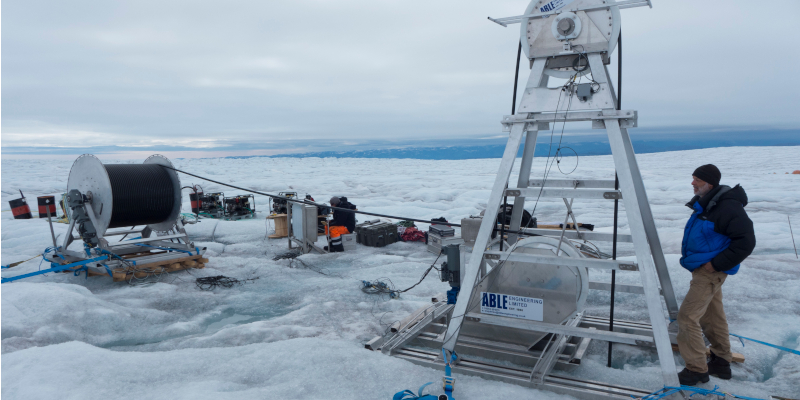
Scientists have used a fibre-optic sensor passed deep into a borehole to obtain the most detailed measurements of ice properties ever taken on the Greenland Ice Sheet.
Their findings will be used to make more accurate models of the future movement of the world's second-largest ice sheet, as the effects of climate change continue to accelerate.
The research team, including Dr Adam Booth from Leeds, used a new technique in which laser pulses are transmitted in a fibre-optic cable to obtain highly detailed measurements of ice properties from the surface of the ice sheet all the way to its base, more than 1,000 metres below.
In contrast to previous studies, which used separate sensors located tens or even hundreds of metres apart, the new approach allows the temperature and structure of the ice to be measured along the entire length of a fibre-optic cable installed in a deep borehole.
"The power of the technique is in its ability to measure temperature and seismic vibrations together."
Dr Booth, a geophysicist in Leeds' School of Earth and Environment, used the cable to record the structural properties of the glacier.
"Fibre-optic technologies are revolutionising our ability to sense ice properties," he said. "I've worked with geophysical data from various sites around the world, but I've never worked with such detailed images.
"This new technique is offering unprecedented capacity to monitor ice deformation and predict how it might evolve.
"The power of the technique is in its ability to measure temperature and seismic vibrations together. When you combine this information, you get a very comprehensive picture of the structure of the glacier."
Mass loss from the Greenland Ice Sheet has increased sixfold since the 1980s and is now the single largest contributor to global sea level rise. About half of this mass loss is from surface meltwater runoff, while the other half is driven by discharge of ice directly into the ocean by fast flowing glaciers that reach the sea.
The research team, which was part-funded by the European Union, was able to compile a highly detailed profile of temperature, which controls how fast ice deforms and ultimately how fast the ice sheet flows.
Drilling a glacier
To install the cable the scientists had to first drill through the glacier. After lowering the cable into the borehole, the team transmitted laser pulses in the cable, and then recorded the distortions in the scattering of light in the cable, which vary depending on how the cable is deformed by seismic vibrations or temperature changes.
Robert Law, a PhD candidate at the Scott Polar Research Institute, University of Cambridge, is lead author of the research paper, published in the journal Science Advances.
He said: "With typical sensing methods, we can only attach about a dozen sensors onto the cable, so the measurements are very spaced out.
"But by using a fibre-optic cable instead, essentially the whole cable becomes a sensor, so we can get precise measurements from the surface all the way to the base."

A member of the research team working near the front of Store Glacier in Greenland
Previously, the temperature of ice sheets was thought to vary as a smooth gradient, with the warmest sections on the surface where the sun hits, and at the base where it is warmed by geothermal energy and friction as the ice sheet grinds across the subglacial landscape toward the ocean.
The new study instead found that the temperature distribution is far more irregular, with ice deformation generating heat within the glacier. This deformation is concentrated at the boundaries between ice of different ages and types.
Although the exact cause of this deformation remains unknown, it may be due to dust in the ice from past volcanic eruptions or large fractures which penetrate several hundred metres below the surface of the ice.
Glacier layers
The researchers found three layers of ice in the glacier. The thickest layer consists of cold and stiff ice which formed over the last 10,000 years.
Below, they found older ice from the last ice age, which is softer and more deformable due to dust trapped in the ice. What surprised the researchers the most, however, was a layer of warm ice more than 70 metres thick at the bottom of the glacier.
The new data will allow the researchers to improve their models of how the Greenland Ice Sheet is currently moving, how it may move in the future, and what that this will mean for global sea-level rise.
Equivalent benefits will be explored at other sites in the coming years: Leeds' capabilities for subsurface optic sensing have recently been expanded, with fibre-optic sensing equipment being supported through a grant from the National Productivity Investment Fund.






